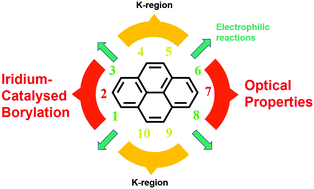Iridium-catalysed borylation of pyrene – a powerful route to novel optoelectronic materials
Abstract
Pyrene represents one of the most attractive units for building organic optoelectronic materials. Most pyrene derivatives that have been reported are 1,3,6,8-substituted pyrenes, as these positions are active to electrophilic reactions. By utilising Ir-catalysed borylation, which is sterically driven, Marder and co-workers have developed an effective way to synthesise 2-, 4-, 2,7-, and 4,9-substituted pyrenes, and the photophysics of these pyrene derivatives has been investigated. Similar methodology has also been used in the study of perylene and others. This review summarises the Ir-catalysed borylation of pyrene and other aromatic hydrocarbons, as well as their contributions to the development of organic optoelectronics.

- This article is part of the themed collections: 2021 Focus and Perspective articles and Boron & Beyond - in celebration of Todd Marder


 Please wait while we load your content...
Please wait while we load your content...